
History of Stockholm
Encyclopedia
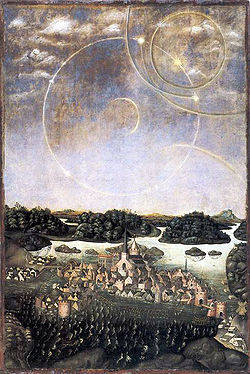
Stockholm
Stockholm is the capital and the largest city of Sweden and constitutes the most populated urban area in Scandinavia. Stockholm is the most populous city in Sweden, with a population of 851,155 in the municipality , 1.37 million in the urban area , and around 2.1 million in the metropolitan area...
, capital of Sweden, for many centuries coincided with the development of what is today known as Gamla stan
Gamla stan
Gamla stan , until 1980 officially Staden mellan broarna , is the old town of Stockholm, Sweden. Gamla stan consists primarily of the island Stadsholmen. The surrounding islets Riddarholmen, Helgeandsholmen, and Strömsborg are officially part of, but not colloquially included in, Gamla stan...
, the Stockholm Old Town. Parts of this article, as a consequence, therefore overlap with the History of Gamla stan.
Furthermore, Stockholm's raison d'être, always was to be the Swedish capital and by far the largest city in the country, and, consequently, retelling the story of the city without including some of the history of Sweden
History of Sweden
Modern Sweden started out of the Kalmar Union formed in 1397 and by the unification of the country by King Gustav Vasa in the 16th century. In the 17th century Sweden expanded its territories to form the Swedish empire. Most of these conquered territories had to be given up during the 18th century...
is virtually impossible.
For a timeline and a list of the historical population see: Timeline of Stockholm history
Timeline of Stockholm history
This is a timeline for the history of Stockholm.- Pre-history :* 750–790: The trade centre Birka is established on Lake Mälaren not far from Stockholm.* c. 975: Birka is abandoned.* c...
Origins
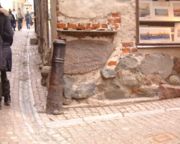
The name 'Stockholm' easily splits into two distinct parts – Stock-holm, "Log-islet", but as no serious explanation to the name has been produced, various myths and legends have attempted to fill in the gap. According to a 17th century myth the population at the viking
Viking
The term Viking is customarily used to refer to the Norse explorers, warriors, merchants, and pirates who raided, traded, explored and settled in wide areas of Europe, Asia and the North Atlantic islands from the late 8th to the mid-11th century.These Norsemen used their famed longships to...
settlement Birka
Birka
During the Viking Age, Birka , on the island of Björkö in Sweden, was an important trading center which handled goods from Scandinavia as well as Central and Eastern Europe and the Orient. Björkö is located in Lake Mälaren, 30 kilometers west of contemporary Stockholm, in the municipality of Ekerö...
decided to found a new settlement, and to determine its location had a log bound with gold drifting in Lake Mälaren
Mälaren
Lake Mälaren is the third-largest lake in Sweden, after Lakes Vänern and Vättern. Its area is 1,140 km² and its greatest depth is 64 m. Mälaren spans 120 kilometers from east to west...
. It landed on present day Riddarholmen
Riddarholmen
Riddarholmen is a small islet in central Stockholm, Sweden. The island forms part of Gamla Stan, the old town, and houses a number of private palaces dating from the 17th century...
where today the Tower of Birger Jarl stands, a building, as a consequence, still often erroneously mentioned as the oldest building in Stockholm. The most established explanation for the name are logs driven into the strait passing north of today's old town
Gamla stan
Gamla stan , until 1980 officially Staden mellan broarna , is the old town of Stockholm, Sweden. Gamla stan consists primarily of the island Stadsholmen. The surrounding islets Riddarholmen, Helgeandsholmen, and Strömsborg are officially part of, but not colloquially included in, Gamla stan...
which dendrochronological
Dendrochronology
Dendrochronology or tree-ring dating is the scientific method of dating based on the analysis of patterns of tree-rings. Dendrochronology can date the time at which tree rings were formed, in many types of wood, to the exact calendar year...
examinations in the late 1970s dated to around 1000. While no solid proofs exists, it is often assumed the Three Crown Castle
Tre kronor (castle)
Tre Kronor or Three Crowns was a castle located in Stockholm, Sweden, on the site where Stockholm Palace is today. It is believed to have been a citadel that Birger Jarl built into a royal castle in the middle of the 13th century...
, which preceded the present Stockholm Palace
Stockholm Palace
The Stockholm Palace is the official residence and major royal palace of the Swedish monarch. . Stockholm Palace is located on Stadsholmen , in Gamla Stan in the capital, Stockholm...
, originated from these wooden structures, and that the medieval city quickly expanded around it in the mid 13th century. In a wider historical context, Stockholm can be thought of as the capital of the Lake Mälaren Region
Mälaren Valley
The Mälaren Valley , occasionally referred to as Stockholm-Mälaren Region , is the easternmost part of Svealand, the catchment area of Lake Mälaren and the surrounding municipalities...
, and as such can trace its origin back to at least two much older cities: Birka
Birka
During the Viking Age, Birka , on the island of Björkö in Sweden, was an important trading center which handled goods from Scandinavia as well as Central and Eastern Europe and the Orient. Björkö is located in Lake Mälaren, 30 kilometers west of contemporary Stockholm, in the municipality of Ekerö...
(c. 790–975) and Sigtuna
Sigtuna
Sigtuna is a locality situated in Sigtuna Municipality, Stockholm County, Sweden with 18 inhabitants in 2005. It is the namesake of the municipality even though the seat is in Märsta....
, which still exists but dominated the region c. 1000–1240 — a capital which has simply been relocated at a number of occasions.
Middle Ages
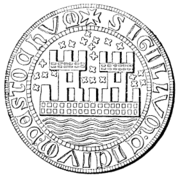
_mlning_av_georg_von_rosen.jpg)
Birger jarl
, or Birger Magnusson, was a Swedish statesman, Jarl of Sweden and a member of the House of Bjelbo, who played a pivotal role in the consolidation of Sweden. Birger also led the Second Swedish Crusade, which established Swedish rule in Finland. Additionally, he is traditionally attributed to have...
and king Valdemar dated 1252. However, the two letters give no information about the appearance of the city and events during the following decades remain diffuse. While the absence of a perpendicular city plan in medieval Stockholm seem do indicate a spontaneous growth, it is known German merchants invited by Birger jarl played an important role in the foundation of the city. Under any circumstance, during the end of the 13th century, Stockholm quickly grew to become not only the largest city in Sweden, but also the de facto Swedish political centre and royal residence. So, from its foundation, Stockholm has been the largest and most important Swedish city, inseparable from and dependent of the Swedish government.
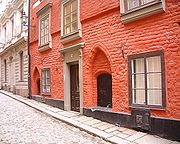
Kalmar Union
The Kalmar Union is a historiographical term meaning a series of personal unions that united the three kingdoms of Denmark, Norway , and Sweden under a single monarch, though intermittently and with a population...
(1397–1523), controlling Stockholm was crucial to anyone aspiring to control the kingdom, and the city was consequently repeatedly besieged by various Swedish-Danish fractions. In 1471, Sten Sture the Elder
Sten Sture the Elder
Sten Sture the Elder was a Swedish statesman and regent of Sweden from .-Background:...
defeated Christian I of Denmark
Christian I of Denmark
Christian I was a Danish monarch, king of Denmark , Norway and Sweden , under the Kalmar Union. In Sweden his short tenure as monarch was preceded by regents, Jöns Bengtsson Oxenstierna and Erik Axelsson Tott and succeeded by regent Kettil Karlsson Vasa...
at the Battle of Brunkeberg
Battle of Brunkeberg
The Battle of Brunkeberg was fought on October 10, 1471 between the Swedish regent Sten Sture the Elder and forces led by Danish king Christian I.-Background:...
only to lose the city to Hans of Denmark in 1497. Sten Sture managed to size power again in 1501 which resulted in a Danish blockade lasting 1502–1509 and eventually a short peace. Hans' son Christian II of Denmark
Christian II of Denmark
Christian II was King of Denmark, Norway and Sweden , during the Kalmar Union.-Background:...
finally conquered it in 1520 and had many leading nobles and burghers of Stockholm beheaded in the so called Stockholm Bloodbath
Stockholm Bloodbath
The Stockholm Bloodbath, or the Stockholm Massacre , took place as the result of a successful invasion of Sweden by Danish forces under the command of King Christian II...
. When King Gustav Vasa
Gustav I of Sweden
Gustav I of Sweden, born Gustav Eriksson of the Vasa noble family and later known simply as Gustav Vasa , was King of Sweden from 1523 until his death....
finally besieged and conquered the city three years later, an event which ended the Kalmar Union and the Swedish Middle Ages, he noted every second building in the city was abandoned.
By the end of the 15th century, the population in Stockholm can be estimated to 5,000–7,000 people, which made it a relatively small town compared to several other contemporary European cities. On the other hand, it was far larger than any other city in Sweden. Many of its inhabitants were Germans and Finns, with the former forming a political and economical elite in the city.
During the Middle Ages, export was administered mostly by German merchants living by the squares Kornhamnstorg
Kornhamnstorg
Kornhamnstorg is a public square in Gamla stan, the old town in central Stockholm, Sweden.Old names : Kornhaffn , Jernboen , Åkaretorget , Kornhampns torget...
("Corn Harbour Square") and Järntorget
Järntorget (Stockholm)
Järntorget is a small public square in Gamla stan, the old town in central Stockholm, Sweden. Located in the southernmost corner of the old town, the square connects the thoroughfares Västerlånggatan and Österlånggatan, while the two alleys, Södra Bankogränd and Norra Bankogränd, stretches east...
("Iron Square") on the southern corner of the city. Regional peasantry supplied the city with food and raw materials, while the craftsmen in the city produced handicrafts, most of whom lived by the central square Stortorget or by the oldest two streets in Stockholm, the names of which still reflects their trade: Köpmangatan
Köpmangatan
Köpmangatan is a street in Gamla stan, the old town of Stockholm, Sweden. A parallel street to Trädgårdsgatan, it is stretching from the central square Stortorget to Köpmantorget, intercepted by Trädgårdstvärgränd, Skeppar Olofs Gränd, Peder Fredags Gränd, Själagårdsgatan, Staffan Sasses Gränd,...
("Merchant's Street") and Skomakargatan
Skomakargatan
Skomakargatan is a street in Gamla stan, the old town of Stockholm, Sweden, Stretching between the square Stortorget and the streets Kindstugatan and Tyska Brinken, it forms a parallel street to Prästgatan and Svartmangatan....
("Shoemaker's Street") in the central part of the city. Other groups lived by the eastern or western thoroughfares, Västerlånggatan
Västerlånggatan
Västerlånggatan is a street in Gamla stan, the old town of Stockholm, Sweden. Stretching southward between the squares Mynttorget and Järntorget, it follows the course of the city's now demolished 13th century defensive wall....
and Österlånggatan
Österlånggatan
Österlånggatan is a street in Gamla stan, the old town of Stockholm, Sweden. Stretching southward from Slottsbacken to Järntorget, it forms a parallel street to Baggensgatan and Skeppsbron...
.
Early Vasa era


After Gustav Vasa's
Gustav I of Sweden
Gustav I of Sweden, born Gustav Eriksson of the Vasa noble family and later known simply as Gustav Vasa , was King of Sweden from 1523 until his death....
siege of Stockholm, he restored the privileges of the city which was beneficiary to the burghers of the city. The king maintained his control over the city by controlling the elections of aldermen and magistrates. By the mid-century, the numbers of officials increased in order to make the management of the city more professional and to ensure the state-controlled trade. Stockholm thus lost much of the independence it had had during the Middle Ages and became politically and financially bound to the state. During the reign of his sons (1561–1611), the city council remained escorted by a royal representative and both magistrates and aldermen were appointed by the king.
Gustav Vasa invited the clergyman Olaus Petri
Olaus Petri
Olof Persson , better known under the Latin form of his name, Olaus Petri , was a clergyman, writer, and a major contributor to the Protestant Reformation in Sweden...
(1493–1552) to become the city secretary of Stockholm. With the two side-by-side, the new ideas of the Protestant Reformation
Protestant Reformation
The Protestant Reformation was a 16th-century split within Western Christianity initiated by Martin Luther, John Calvin and other early Protestants. The efforts of the self-described "reformers", who objected to the doctrines, rituals and ecclesiastical structure of the Roman Catholic Church, led...
could be quickly implemented, and sermons in the church where held in Swedish starting in 1525 and Latin abolished in 1530. A consequence of this development was a need for separate churches for the numerous German and Finnish-speaking
Sweden Finns
Sweden Finns are a Finnish speaking minority in Sweden. The Finnish-speaking Swedes are not to be confused with the Swedish speaking Finland-Swedes in Finland . In 2008 there were over 675 000 people in Sweden who were either born in Finland or have at least one parent or grandparent who was born...
citizens and during the 1530 the still-existent German
German Church, Stockholm
Tyska kyrkan , sometimes called St. Gertrude's Church , is a church in Gamla stan, the old town in central Stockholm, Sweden....
and Finnish parishes were created. The king was, however, not favourably disposed to older chapels and churches in the city, and he ordered churches and monasteries on the ridges surrounding the city to be demolished, together with the numerous charitable institutions.
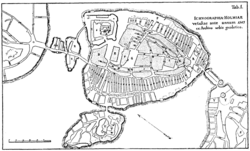
Stockholm archipelago
The Stockholm archipelago is the largest archipelago of Sweden, and one of the largest archipelagos of the Baltic Sea.-Geography:The archipelago extends from Stockholm roughly 60 kilometers to the east...
, Vaxholm
Vaxholm
Vaxholm is a locality and the seat of Vaxholm Municipality, Stockholm County, Sweden. It is located in the Stockholm archipelago. The name Vaxholm comes from Vaxholm Castle, which was constructed in 1549 on an islet with this name on the inlet to Stockholm, for defense purposes, by King Gustav...
was created to guard the inlet from the Baltic. While the medieval structure of Stockholm remained mostly unaltered during the 16th century, the city's social and economic importance grew to the extent that no king could permit the city to determine its own faith – the most important export item being bar iron and the most important destination Lübeck
Lübeck
The Hanseatic City of Lübeck is the second-largest city in Schleswig-Holstein, in northern Germany, and one of the major ports of Germany. It was for several centuries the "capital" of the Hanseatic League and, because of its Brick Gothic architectural heritage, is listed by UNESCO as a World...
. During the reign of Vasa's sons, trade led many Swedes to settle in the city, but the trade and the capital needed to control it was largely in the hands of the king and German merchants from Lübeck and Danzig. Throughout the era, Sweden could hardly claim the level of government and bureaucracy requisite to a capital in the modern sense, but Stockholm was the kingdom's strongest bastion and the king's main residence. As Eric XIV's pretensions were on par with those of Renaissance princes on the continent, he afforded himself the largest court his finances could possibly support, and the royal castle was thus the biggest employer in the city.
Around 1560–80, most of the citizens, some 8.000 people, still lived on Stadsholmen
Stadsholmen
Stadsholmen is the historical name of an island in the centre of Stockholm, Sweden. Together with the small islands Riddarholmen and Helgeandsholmen it forms the Old town of Stockholm....
. This central island was at this time densely settled and the city was now expanding on the ridges surrounding the city. Stockholm had no private palaces at this time and the only larger buildings were the castle, the church, and the former Greyfriars
Franciscan
Most Franciscans are members of Roman Catholic religious orders founded by Saint Francis of Assisi. Besides Roman Catholic communities, there are also Old Catholic, Anglican, Lutheran, ecumenical and Non-denominational Franciscan communities....
monastery on Riddarholmen
Riddarholmen
Riddarholmen is a small islet in central Stockholm, Sweden. The island forms part of Gamla Stan, the old town, and houses a number of private palaces dating from the 17th century...
. The surrounding ridges, unable to boast a single timber framed
Timber framing
Timber framing , or half-timbering, also called in North America "post-and-beam" construction, is the method of creating structures using heavy squared off and carefully fitted and joined timbers with joints secured by large wooden pegs . It is commonplace in large barns...
building, were mostly used for activities that either required a lot of space, produced odours, or could cause fire. Even though some burghers had secondary residences outside the city, the population living on the ridges, perhaps a quarter of the city's population, were mostly poor, including the royal personnel occupying the ridges north of the city.
Great Power Era

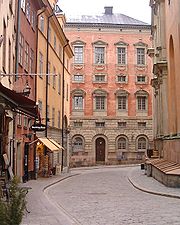
Thirty Years' War
The Thirty Years' War was fought primarily in what is now Germany, and at various points involved most countries in Europe. It was one of the most destructive conflicts in European history....
(1618–1648), Sweden was determined never to repeat the embarrassment experienced following the death of Gustavus II Adolphus
Gustavus Adolphus of Sweden
Gustav II Adolf has been widely known in English by his Latinized name Gustavus Adolphus Magnus and variously in historical writings also as Gustavus, or Gustavus the Great, or Gustav Adolph the Great,...
(1594–1632) when Stockholm, still medieval in character, caused hesitation on whether to invite foreign statesmen for fear the lamentable appearance might undermine the nation's authority. Therefore, Stockholm saw many ambitious city plans during the era, of which those for the ridges surrounding today's old town still stands. In accordance to the mercantilism
Mercantilism
Mercantilism is the economic doctrine in which government control of foreign trade is of paramount importance for ensuring the prosperity and security of the state. In particular, it demands a positive balance of trade. Mercantilism dominated Western European economic policy and discourse from...
of the era, trade and industry was concentrated to cities were it was easier to control, and Stockholm was of central importance. In a letter in 1636, Chancellor Axel Oxenstierna
Axel Oxenstierna
Axel Gustafsson Oxenstierna af Södermöre , Count of Södermöre, was a Swedish statesman. He became a member of the Swedish Privy Council in 1609 and served as Lord High Chancellor of Sweden from 1612 until his death. He was a confidant of first Gustavus Adolphus and then Queen Christina.Oxenstierna...
(1583–1654) wrote that evolving the Swedish capital was a prerequisite for the nation's power and strength and that this would bring all the other cities on their feet. Increased state intervention on city level was not unique to Sweden at this time, but it was probably more prominent in the case of Stockholm than anywhere else in Europe. To this end, the government of the city was reformed and the former volunteered magistrates gradually replaced by professionals with a theoretical education.
Population and city plans
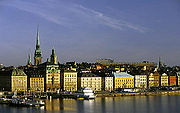
The process of reshaping Stockholm was initiated by a major fire in 1625 which destroyed the south-western part of today's old town. As a result, two new boulevard
Boulevard
A Boulevard is type of road, usually a wide, multi-lane arterial thoroughfare, divided with a median down the centre, and roadways along each side designed as slow travel and parking lanes and for bicycle and pedestrian usage, often with an above-average quality of landscaping and scenery...
-like streets were created — Stora Nygatan
Stora Nygatan
Stora Nygatan is a street in Gamla stan, the old town in central Stockholm, Sweden.Old names : nyegatun , nyia gaatan, den nya Konnungsgatun, stora konungsgatun , den store Nye gatan , Konnungsgatun , Nye gaten, KongsGaten , Kongs- eller stoora Nygatan, stora Kongs- el' Nygatan , Stora...
and Lilla Nygatan
Lilla Nygatan
Lilla Nygatan is a street in Gamla stan, the old town of Stockholm, Sweden. Stretching from the square Munkbron south to Kornhamnstorg, the street in intercepted by Yxsmedsgränd, Kåkbrinken, Schönfeldts Gränd, Tyska Brinken, and Lejonstedts Gränd, while forming a parallel street to Stora Nygatan...
— and along the eastern waterfront the medieval wall was replaced by a row of prestigious palaces — Skeppsbron
Skeppsbron
Skeppsbron is both a street and a quay in Gamla stan, the old town of Stockholm, capital of Sweden, stretching from the bridge Strömbron in front of the Royal Palace southward to Slussen....
.
For the ridges surrounding surrounding the city – Norrmalm, Östermalm, Kungsholmen
Kungsholmen
Kungsholmen is an island in Lake Mälaren in Sweden, part of Stockholm City. It is situated north of Riddarfjärden and considered part of the historical province Uppland....
, and Södermalm
Södermalm
Södermalm, often shortened to "Söder", is a district in central Stockholm. It covers the large island formerly called "Åsön". With a population of 99,685, it is one of the most densely populated districts of Scandinavia...
– new city plans were worked out to create wide and straight artery streets. The project was implemented so thoroughly, in several parts of the city no traces exist of the previous medieval structures. Many of the streets from this era are still extant, and some of those proposed have been realised with some minor modifications.
Population grew from less than 10,000 in the early 17th century to more than 50,000 in mid 1670s.
The city's income rose from 18,595 daler
Swedish riksdaler
The riksdaler was the name of a Swedish coin first minted in 1604. Between 1777 and 1873, it was the currency of Sweden. The daler, like the dollar, was named after the German Thaler. The similarly named Reichsthaler, rijksdaalder, and rigsdaler were used in Germany and Austria-Hungary, the...
in 1635–36 to 81,480 daler in 1644. In 1642, approximately 60 per cent of this sum was spent on construction works.
Trade
Other Swedish cities were deprived of their export privileges by the so called "BothnianGulf of Bothnia
The Gulf of Bothnia is the northernmost arm of the Baltic Sea. It is situated between Finland's west coast and Sweden's east coast. In the south of the gulf lie the Åland Islands, between the Sea of Åland and the Archipelago Sea.-Name:...
Trade Coercion
Coercive monopoly
In economics and business ethics, a coercive monopoly is a business concern that prohibits competitors from entering the field, with the natural result being that the firm is able to make pricing and production decisions independent of competitive forces...
" (Bottniska handelstvånget). Most Swedish cities were granted a trade monopoly over a limited surrounding area, but for Stockholm most of the lands surrounding the Gulf of Bothnia
Gulf of Bothnia
The Gulf of Bothnia is the northernmost arm of the Baltic Sea. It is situated between Finland's west coast and Sweden's east coast. In the south of the gulf lie the Åland Islands, between the Sea of Åland and the Archipelago Sea.-Name:...
formed part of the city's trade territory. However, the state-granted monopoly was not the only thing that favoured Stockholm at this time. It was one of the best natural harbours of the era and throughout the 17th century countless foreign visitors marvelled at the sight of large ships "with 60 or 70 canons" moored along the eastern quay next to the royal castle.
In contrast with other Swedish cities, all of which were self-supporting, Stockholm was completely dependent of the transit passing through the city—it had, for example, about the same number of domestic animals as Uppsala
Uppsala
- Economy :Today Uppsala is well established in medical research and recognized for its leading position in biotechnology.*Abbott Medical Optics *GE Healthcare*Pfizer *Phadia, an offshoot of Pharmacia*Fresenius*Q-Med...
, which only had ten per cent the population of the capital. All goods brought into Stockholm had to pass through one of six customs stations, and approximately three-fourths of them were exported from the city. Half of the remaining items, mostly fishery products, were delivered from the Baltic, and corn came from the Lake Mälaren region. However, during the latter half of the century, the rapidly growing capital could not be supported by the Lake Mälaren region alone and therefore became dependent of corn imported from the provinces.
Sweden had played a passive role in international trade during the 16th century; German merchants and ships managed the export of Swedish primary products such as osmond iron, raw copper, and butter. This export was largely regarded as a means of securing the import of items not available in Sweden, such as salt, wine, and luxury goods demanded at the court. With the introduction of a mercantile
Mercantilism
Mercantilism is the economic doctrine in which government control of foreign trade is of paramount importance for ensuring the prosperity and security of the state. In particular, it demands a positive balance of trade. Mercantilism dominated Western European economic policy and discourse from...
doctrine around 1620, trade became a keystone to governmental income and the Swedish economy subsequently focused on export, not of raw materials, but of refined products. Over the entire period (c. 1590–1685), Stockholm's share of the national economy remained stable at around two-thirds, but during the first half of the 17th century, export grew fourfold and import fivefold. Most goods were delivered to the Netherlands in the mid-17th Century and to the UK in the early 18th Century.
Age of Liberty (1718–1772)
| Population | ||
|---|---|---|
| Late 17th century | 55–66.000 | |
| Around 1720 | 45.000 | |
| Mid 18th century | 60.000 | |
| Mid 19th century | 90.000 | |
| Social stratification 1769–1850 (per cent) |
||
| Class | 1769 | 1850 |
| Upper | 13 | 7 |
| Middle | 40 | 12 |
| Lower | 47 | 81 |
Following the Greater Wrath
Greater Wrath
The Greater Wrath is a term used in Finnish history for the Russian invasion and subsequent military occupation of Eastern Sweden, now Finland, from 1714 until the treaty of Nystad 1721, which ended the Great Northern War, although sometimes the term is used to denote all of the Great Northern...
and the Treaty of Nystad
Treaty of Nystad
The Treaty of Nystad was the last peace treaty of the Great Northern War. It was concluded between the Tsardom of Russia and Swedish Empire on 30 August / 10 September 1721 in the then Swedish town of Nystad , after Sweden had settled with the other parties in Stockholm and Frederiksborg.During...
in 1722, Sweden's role as a major European power was over, and the decades that followed brought even more disasters. Black death
Black Death
The Black Death was one of the most devastating pandemics in human history, peaking in Europe between 1348 and 1350. Of several competing theories, the dominant explanation for the Black Death is the plague theory, which attributes the outbreak to the bacterium Yersinia pestis. Thought to have...
and the sufferings caused by the Great Northern War
Great Northern War
The Great Northern War was a conflict in which a coalition led by the Tsardom of Russia successfully contested the supremacy of the Swedish Empire in northern Central Europe and Eastern Europe. The initial leaders of the anti-Swedish alliance were Peter I the Great of Russia, Frederick IV of...
s made Stockholm the capital of a shrinking nation, sunk a despair which would deepen even further when Sweden lost Finland in 1809. Notwithstanding Sweden's partial recover of spirit with the union with Norway
Union between Sweden and Norway
The Union between Sweden and Norway , officially the United Kingdoms of Sweden and Norway, consisted of present-day Sweden and Norway between 1814 and 1905, when they were united under one monarch in a personal union....
in 1814, during the period 1750–1850, Stockholm was a stagnating city, with a dwindling population and widespread unemployment, marked by ill-health, poverty, alcoholism, and rampant mortality. The Mälaren region lost in influence to the benefit of south-western Sweden, and as population and welfare dwindled in the capital, there was a leveling of social classes. Wars and alcohol abuse resulted in a surplus of women during the period, with widows outnumbering widowers six to one in 1850. Stockholm was marked by an absence of children, caused by the number of unmarried people and high infant mortality. Average length of life was limited to 44, but those who survived infancy were likely to get about as old as people do today, especially if they could avoid hard labour.
A stratification into three social groups can be made for this era :
- individuals of rank and officers
- craftsmen, small-scale entrepreneurs, and officials
- journeymen, assistants, workers, soldiers, servants, paupers, and prisoners.
Women were associated with their husband's status. However, as craftsmen saw their status sink with the introduction of industrialism, the proletarian class grew during the period. There also was an economic segregation in the city, with the present old town and the lower parts of Norrmalm being the wealthiest (more than 150% above average); the suburbs (today part of central Stockholm) were poor (50% below average).
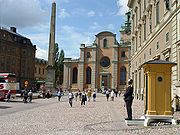

Mercantilism
Mercantilism is the economic doctrine in which government control of foreign trade is of paramount importance for ensuring the prosperity and security of the state. In particular, it demands a positive balance of trade. Mercantilism dominated Western European economic policy and discourse from...
model introduced the previous century was further developed, with domestic production promoted by loans and bounties and import limited to raw materials not available in Sweden by tolls. The era saw the rise of the so called "Skeppsbro Nobility" (Skeppsbroadeln), the wealthy wholesalers at Skeppsbron
Skeppsbron
Skeppsbron is both a street and a quay in Gamla stan, the old town of Stockholm, capital of Sweden, stretching from the bridge Strömbron in front of the Royal Palace southward to Slussen....
who made a fortune by delivering bar iron to the international market and by controlling the chartered companies
Chartered company
A chartered company is an association formed by investors or shareholders for the purpose of trade, exploration and colonization.- History :...
. The most successful of them was the Swedish East India Company
Swedish East India Company
The Swedish East India Company was founded in Gothenburg, Sweden, in 1731 for the purpose of conducting trade with the Far East...
(1731–1813) which had its headquarters in Gothenburg
Gothenburg
Gothenburg is the second-largest city in Sweden and the fifth-largest in the Nordic countries. Situated on the west coast of Sweden, the city proper has a population of 519,399, with 549,839 in the urban area and total of 937,015 inhabitants in the metropolitan area...
, but was of significant importance to Stockholm because of the shipbuilding yards, the trade houses, and the exotic products imported by the company. Furthermore, before these ships left Stockholm some 100–150 men per ship were recruited, most of them in the city, and as a single trip to China would take 1–2 years the company had a huge impact on Stockholm during this era.
During the 18th century, several devastating fires destroyed entire neighbourhoods which resulted in building code
Building code
A building code, or building control, is a set of rules that specify the minimum acceptable level of safety for constructed objects such as buildings and nonbuilding structures. The main purpose of building codes are to protect public health, safety and general welfare as they relate to the...
s being introduced. They improved fire safety by prohibiting wooden buildings and further embellished the city by implementing the 17th century city plans. In the old town, the new royal palace
Stockholm Palace
The Stockholm Palace is the official residence and major royal palace of the Swedish monarch. . Stockholm Palace is located on Stadsholmen , in Gamla Stan in the capital, Stockholm...
was gradually completed and the exterior of the Storkyrkan
Storkyrkan
Sankt Nikolai kyrka , most commonly known as Storkyrkan and Stockholms domkyrka , is the oldest church in Gamla Stan, the old town in central Stockholm, Sweden. It is an important example of Swedish Brick Gothic...
church was adopted to it. The skilled artists and craftsmen working for the royal court formed an elite which considerably raised the artistic standards in the capital.
Gustavian era (1772–1809)
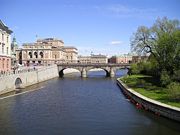

Gustav III of Sweden
Gustav III was King of Sweden from 1771 until his death. He was the eldest son of King Adolph Frederick and Queen Louise Ulrica of Sweden, she a sister of Frederick the Great of Prussia....
Stockholm managed to maintain its role as the political centre of Sweden and developed culturally.
The king had a great interest for the city's development. He created the Gustav Adolf square and had the Royal Opera
Royal Swedish Opera
Kungliga Operan is Sweden's national stage for opera and ballet.-Location and Environment:...
inaugurated there in 1782 — in accordance to the original intentions of Tessin the Younger
Nicodemus Tessin the Younger
Count Nicodemus Tessin the Younger was a Swedish Baroque architect, city planner, and administrator.The son of Nicodemus Tessin the Elder and the father of Carl Gustaf Tessin, Tessin the Younger was the middle-most generation of the brief Tessin dynasty, which have had a lasting influence on...
for a monumental square north of the palace. The façade of Arvfurstens palats
Arvfurstens palats
Arvfurstens palats is a palace located at Gustav Adolfs Torg in central Stockholm.Designed by Erik Palmstedt, the palace was originally the private residence of Princess Sophia Albertina. It was built 1783-1794 and declared a historical monument in 1935 and subsequently restored by Ivar Tengbom...
on the opposite side is identical to the now replaced façade of the opera.
The neoclassical bridge Norrbro
Norrbro
Norrbro is an arch bridge over Norrström in central Stockholm. It extends north from the northern front of the Stockholm Palace passing over Helgeandsholmen in front of the parliament building, Riksdagen, and from there over to Gustaf Adolfs torg...
, designed by Erik Palmstedt
Erik Palmstedt
Erik Palmstedt was an outstanding Swedish architect working for the court circle of Gustav III, where he was in the forefront of Neoclassical style and at the heart of a social and intellectual circle that formed round him...
and constructed 1741–1807, was an ambitious project that caused the centre of the city to gradually move out of the medieval city.
The colourful and often burlesque descriptions of Stockholm by troubadour and composer Carl Michael Bellman
Carl Michael Bellman
was a Swedish poet and composer. Bellman is a central figure in the Swedish song tradition and remains a very important influence in Swedish music, as well as in Scandinavian literature in general, to this day....
are still popular.
The period ended as King Gustav IV Adolf
Gustav IV Adolf of Sweden
Gustav IV Adolf of Sweden also Gustav Adolph was King of Sweden from 1792 until his abdication in 1809. He was the son of Gustav III of Sweden and his queen consort Sophia Magdalena, eldest daughter of Frederick V of Denmark and his first wife Louise of Great Britain. He was the last Swedish...
was deposed in 1809 in a coup d'état. The loss of Finland that same year meant Stockholm ceased to be the geographical centre of the Swedish kingdom.
Early industrial era (1809–1850)
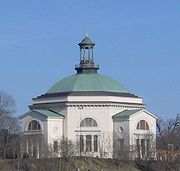
Carl Christoffer Gjörwell
Carl Christoffer Gjörwell was a city architect in Stockholm, Sweden. He was the son of Carl Christoffer Gjörwell ....
, both were commissioned by the military. Due to the general stagnation, few other constructions were realised — in average ten smaller residential buildings per year — additions which the ambitious city plans of the 17th century could easily handle.
During the later half of the 18th century real income
Real income
Real income is the income of individuals or nations after adjusting for inflation. It is calculated by subtracting inflation from the nominal income...
dwindled to reach an all time low in 1810 when it corresponded to roughly half that of the 1730s; public officials being those worst affected. Norrköping
Norrköping
Norrköping is a city in the province of Östergötland in eastern Sweden and the seat of Norrköping Municipality, Östergötland County. The city has a population of 87,247 inhabitants in 2010, out of a municipal total of 130,050, making it Sweden's tenth largest city and eighth largest...
became the greatest manufacturing city of Sweden and Gothenburg
Gothenburg
Gothenburg is the second-largest city in Sweden and the fifth-largest in the Nordic countries. Situated on the west coast of Sweden, the city proper has a population of 519,399, with 549,839 in the urban area and total of 937,015 inhabitants in the metropolitan area...
developed into the key trading port because of its location on the North Sea
North Sea
In the southwest, beyond the Straits of Dover, the North Sea becomes the English Channel connecting to the Atlantic Ocean. In the east, it connects to the Baltic Sea via the Skagerrak and Kattegat, narrow straits that separate Denmark from Norway and Sweden respectively...
.
Most people still lived within the present Old Town, with a growth along the eastern shore. Population also grew on the surrounding ridges, more so in the wealthy district Norrmalm and less so in the poor district Södermalm
Södermalm
Södermalm, often shortened to "Söder", is a district in central Stockholm. It covers the large island formerly called "Åsön". With a population of 99,685, it is one of the most densely populated districts of Scandinavia...
. However, many of the ridges surrounding the city were slums mostly rural in character without water and sewage and frequently ravaged by cholera
Cholera
Cholera is an infection of the small intestine that is caused by the bacterium Vibrio cholerae. The main symptoms are profuse watery diarrhea and vomiting. Transmission occurs primarily by drinking or eating water or food that has been contaminated by the diarrhea of an infected person or the feces...
.
Late industrial era (1850–1910)
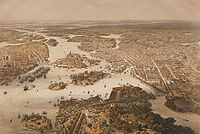
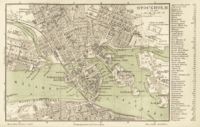
While steam engines were introduced in Stockholm in 1806 with the Eldkvarn
Eldkvarn
Eldkvarn was a grand gristmill in central Stockholm that burned in 1878 — an event which was known as "the fire of the century". It was located where today the Stockholm City Hall stands....
mill, it took until the mid-19th century for industrialization to take off. Two factories, Ludvigsberg and Bolinder, constructed in the 1840s were followed by many others, and the economic development that succeeded resulted in some 800 new buildings being constructed 1850–70 — many of which were located in the Klara district and subsequently demolished in the Redevelopment of Norrmalm
Redevelopment of Norrmalm
The redevelopment of Norrmalm was a major revision of the city plan for lower Norrmalm in Stockholm, Sweden, which was realised during the 1950s, 1960s, and 1970s. The renewal resulted in the old Klara quarters being replaced for the modern city of Stockholm, according to rigorist CBD ideas, while...
1950–70.
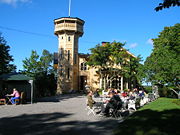
Skeppsbron
Skeppsbron is both a street and a quay in Gamla stan, the old town of Stockholm, capital of Sweden, stretching from the bridge Strömbron in front of the Royal Palace southward to Slussen....
and Strandvägen
Strandvägen
Strandvägen is a boulevard on Östermalm in central Stockholm, Sweden. Completed just in time for the Stockholm World's Fair 1897, it quickly became known as one of the most prestigious addresses in town....
, and the railway brought Stockholm closer to continental Europe — an event which additionally lead to the creation of the first suburb Liljeholmen
Liljeholmen
Liljeholmen is a district in South Stockholm, organized into the borough with the same name.In 1860 Liljeholmen became the first suburb outside Stockholm city limit...
where railway workshops were located. As the railway was extended further north, Stockholm Central Station
Stockholm Central Station
Stockholm Central Station is the largest railway station in Sweden. The station is situated in the district of Norrmalm at Vasagatan/Central Plan. Opened July 18, 1871, the station is the largest in Sweden, with over 200,000 visitors daily...
was inaugurated in 1871. The first horse-pulled trams were introduced in 1877. Long before the railway, steam engines became common on boats which resulted in many summertime residences being built around Stockholm. But the booming urban development was also notable in central Stockholm where several prominent Neo-Renaissance
Neo-Renaissance
Renaissance Revival is an all-encompassing designation that covers many 19th century architectural revival styles which were neither Grecian nor Gothic but which instead drew inspiration from a wide range of classicizing Italian modes...
buildings were built, including the Academy of Music
Royal Swedish Academy of Music
The Royal Swedish Academy of Music or Kungl. Musikaliska Akademien, founded in 1771 by King Gustav III, is one of the Royal Academies in Sweden...
and Södra Teatern
Södra Teatern
Södra Teatern is a theatre in Stockholm, Sweden. Located in the popular "Söder"-district , it's one of Stockholms most appreciated private theatres. Established in 1859, it's Stockholm's oldest private theatre...
.

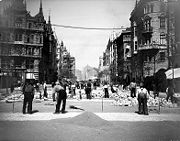
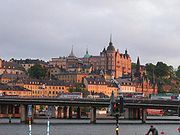
Albert Lindhagen
Klas Albert Lindhagen was a Swedish city planner, lawyer, and politician. He is mostly remembered for his city plans for Stockholm produced in the late 19th century.- Biography :...
produced a city plan for the ridges (malmarna) designed to offer citizens light, fresh air and access to Swedish nature by mean of parks and plantations. To this goal, he proposed a system of esplanade
Esplanade
An esplanade is a long, open, level area, usually next to a river or large body of water, where people may walk. The original meaning of esplanade was a large, open, level area outside fortress or city walls to provide clear fields of fire for the fortress' guns...
s culminating in Sveavägen
Sveavägen
Sveavägen is a major street in Stockholm, Sweden. The street starts at Sergels torg in the city center and goes north out of the city towards the Haga Park. It is often known as the busiest road in Sweden....
, a 2 km long and 70 m wide boulevard inspired by Champs Elysées. 1877–80 new city plans were finally passed for central Stockholm, which made the city well-prepared for the major expansion that followed. During the 1880s more than 2.000 buildings were added on the ridges and the population grew from 168.000 to 245.000. At the end of the century, less than 40 per cent of the residents were born in Stockholm.
While this demand for housing was mostly dealt with by private entrepreneurs who built on pure speculation, street width and building heights were strictly regulated by the new city plans which ensured the city that evolved was given a uniform design. A trend initiated by the Bünsow House at Strandvägen
Strandvägen
Strandvägen is a boulevard on Östermalm in central Stockholm, Sweden. Completed just in time for the Stockholm World's Fair 1897, it quickly became known as one of the most prestigious addresses in town....
, the 1880s saw many monumental brick buildings evolve, including Gamla Riksarkivet
Gamla Riksarkivet
Gamla Riksarkivet is a building at Arkivgatan 3 on Riddarholmen in Stockholm, Sweden. Riksarkivet, the Swedish National Archives, were located in the building until 1968....
and the Norstedt Building
Norstedt Building
The Norstedt Building is the main office of P.A. Norstedt & Söner AB on Riddarholmen in Stockholm, Sweden.The building, designed by Magnus Isæus and built in 1882-91, features a spire-like roof, which is a well-known silhouette on the skyline of central Stockholm.Bridge Vasabron is passing in...
on Riddarholmen
Riddarholmen
Riddarholmen is a small islet in central Stockholm, Sweden. The island forms part of Gamla Stan, the old town, and houses a number of private palaces dating from the 17th century...
. Before the end of the decade most new buildings were equipped with electricity and telephones were increasingly common. During the 1890, the Neo-Renaissance plaster architecture was replaced by structures in brick and natural stone, largely inspired by French Renaissance architecture. Around what still was factories outside the customs of Stockholm, shacks whose sanitary conditions defied all description evolved. Before the end of the century, however, these were transformed into municipal societies, which facilitated regulation of health and construction, and by the turn of the century the expansion had continued far beyond the city limits, with villa suburbs initiated by individuals adding a mix of purely speculative structures and more qualitative ambitions. The new century saw the introduction of Art Nouveau
Art Nouveau
Art Nouveau is an international philosophy and style of art, architecture and applied art—especially the decorative arts—that were most popular during 1890–1910. The name "Art Nouveau" is French for "new art"...
with the Central Post Office Building by Boberg
Ferdinand Boberg
Ferdinand Boberg, born 11 April 1860 in Falun, died 7 May 1946 in Stockholm, was a Swedish architect.He was one of the most productive and prominent architects of Stockholm around the turn of the 20th century. Among his most famous work is an electrical plant at Björns Trädgård in Stockholm, that...
(1898–1904) and Neo-Baroque with the Riksdag
Riksdag building
The Riksdag building is the seat of the Parliament of Sweden. It is located on Helgeandsholmen in Stockholm.- History :...
(1894–1906). Throughout the 1910s, trams were electrified and cars were rolling on the streets of Stockholm.
During this period, Stockholm further developed as a cultural and educational centre. In the 19th century, a number of scientific institutes opened in Stockholm, for example the Karolinska Institute. The General Art and Industrial Exposition
General Art and Industrial Exposition of Stockholm (1897)
The General Art and Industrial Exposition of Stockholm of 1897 also known as Stockholm Exhibition or Stockholm World's Fair was a World's Fair staged in 1897 in Stockholm, Sweden....
, an international exhibition of World's Fair
World's Fair
World's fair, World fair, Universal Exposition, and World Expo are various large public exhibitions held in different parts of the world. The first Expo was held in The Crystal Palace in Hyde Park, London, United Kingdom, in 1851, under the title "Great Exhibition of the Works of Industry of All...
status, was held on the island of Djurgården in 1897.
20th century
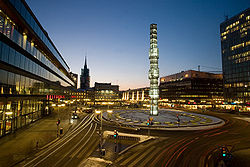
The city continued to expand and new districts were created, for example Rinkeby
Rinkeby
Rinkeby is a district in Rinkeby-Kista borough, Stockholm, Sweden. Rinkeby had 15,051 inhabitants as at December 31, 2007.Rinkeby is noted for its high concentration of immigrants and people with immigrant ancestry...
, Tensta
Tensta
Tensta is a district in Spånga-Tensta borough, Stockholm, Sweden. There are about 6,000 apartments in Tensta and a population of 17,083 as of December 31, 2007....
, and Sollentuna, some with high proportions of immigrants. Meanwhile, the inner city (Norrmalm) went through a criticised as well as admired wave of modernisation in the post-war
Post-war
A post-war period or postwar period is the interval immediately following the ending of a war and enduring as long as war does not resume. A post-war period can become an interwar period or interbellum when a war between the same parties resumes at a later date...
period, the Redevelopment of Norrmalm
Redevelopment of Norrmalm
The redevelopment of Norrmalm was a major revision of the city plan for lower Norrmalm in Stockholm, Sweden, which was realised during the 1950s, 1960s, and 1970s. The renewal resulted in the old Klara quarters being replaced for the modern city of Stockholm, according to rigorist CBD ideas, while...
, securing the city's geographical center as the political and business center for the future.
In 1923 the Stockholm municipal government moved to a new building, the Stockholm City Hall
Stockholm City Hall
Stockholm City Hall is the building of the Municipal Council for the City of Stockholm in Sweden. It stands on the eastern tip of Kungsholmen island, next to Riddarfjärden's northern shore and facing the islands of Riddarholmen and Södermalm. It houses offices and conference rooms as well as...
. The Stockholm International Exhibition
Stockholm International Exhibition (1930)
The Stockholm Exhibition was an exhibition held in 1930 in Stockholm, Sweden, that had a great impact on the architectural styles known as Functionalism and International Style....
was held in 1930. In 1967 the city of Stockholm was integrated into Stockholm County
Stockholm County
Stockholm County is a county or län on the Baltic sea coast of Sweden. It borders Uppsala County and Södermanland County. It also borders Mälaren and the Baltic Sea. The city of Stockholm is the capital of Sweden. Stockholm County is divided by the historic provinces of Uppland and Södermanland...
.

